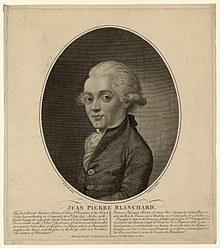Jean-Pierre Blanchard
Jean-Pierre Blanchard | |
|---|---|
 Jean-Pierre Blanchard, engraving after a portrait by Richard Livesay | |
| Born | 4 July 1753 Les Andelys, France |
| Died | 7 March 1809(1809-03-07) (aged 55) The Hague, Holland |
| Nationality | French |
| Occupation | Inventor |
| Known for | Ballooning |
| Spouse(s) | Victoire Lebrun {abandoned} Marie Madeleine-Sophie Armant |
Jean-Pierre [François] Blanchard (French pronunciation: [ʒɑ̃ pjɛʁ blɑ̃ʃaʁ]; 4 July 1753 – 7 March 1809) was a French inventor, best known as a pioneer of gas balloon flight, who distinguished himself in the conquest of the air in a balloon. Notable for his successful hydrogen balloon flight in Paris on 2 March 1784, Blanchard later moved to London and undertook flights with varying propulsion mechanisms. His historic achievement came on 7 January 1785, crossing the English Channel from Dover Castle to Guînes in about 2½ hours, receiving acclaim from Louis XVI and earning a substantial pension.
Touring Europe, Blanchard demonstrated his balloons and showcased the modern parachute, which he later used for a successful escape in 1793 when his hydrogen balloon ruptured. In 1793, he conducted the first balloon flight in the Americas, witnessed by President George Washington. Married to Sophie Blanchard in 1804, Blanchard suffered a fatal heart attack in his balloon in 1808, with his widow continuing balloon demonstrations until her accidental death.
Biography
1784 – Flights in Paris
Blanchard made his first successful balloon flight in Paris on 2 March 1784, in a hydrogen gas balloon launched from the Champ de Mars. The first successful manned balloon flight had taken place on 21 November 1783, when Pilâtre de Rozier and the Marquis d'Arlandes took off at the Palace of Versailles in a free-flying hot air balloon constructed by the Montgolfier brothers. The first manned hydrogen balloon flight had taken place on 1 December 1783, when Professor Jacques Charles and Nicolas-Louis Robert launched the first gas balloon from the Jardin des Tuileries in Paris. Blanchard's flight nearly ended in disaster, when one spectator (Dupont de Chambon, a contemporary of Napoleon at the École militaire de Brienne) slashed at the balloon's mooring ropes and oars with his sword after being refused a place on board. Blanchard intended to "row" northeast to La Villette but the balloon was pushed by the wind across the Seine to Billancourt and back again, landing in the rue de Sèvres. Blanchard adopted the Latin tag Sic itur ad astra as his motto.[citation needed]
The early balloon flights triggered a phase of public "balloonomania", with all manner of objects decorated with images of balloons or styled au ballon, from ceramics to fans and hats. Clothing au ballon was produced with exaggerated puffed sleeves and rounded skirts, or with printed images of balloons. Hair was coiffed à la montgolfier, au globe volant, au demi-ballon, or à la Blanchard.[1]
1784 – Flights in London
Blanchard moved to London in August 1784, where he took part in a flight on 16 October 1784 with John Sheldon, just a few weeks after the first flight in Britain (and the first outside France), when Italian Vincenzo Lunardi flew from Moorfields to Ware on 15 September 1784. Blanchard's propulsion mechanisms – flapping wings and a windmill – again proved ineffective, but the balloon flew some 115 km from Lewis Lochée’s military academy in Little Chelsea, landing in Sunbury and then taking off again to end in Romsey. Blanchard took a second flight on 30 November 1784, taking off with an American, Dr John Jeffries, from the Rhedarium behind Green Street[2] Mayfair, London to Ingress in Kent.
1785 – First flight over the English Channel
50°50′31″N 1°52′02″E / 50.841997365°N 1.867341242°E / 50.841997365; 1.867341242 (Jean-Pierre Blanchard))MDCCLXXXV
Jean-Pierre Blanchard of Les Andelys in Normandy
accompanied by Jean Jefferies English (sic)
Leaving from Dover Castle
in an Aerostat.
January 7th at a quarter past one,
was the first to cross the air
above Pas-de-Calais
and descended after three and a quarter hours
in the very place where the inhabitants of Guines
raised this column
to the glory of the two travellers.
These aeronauts were received on their descent by
P. Eliz Casin d'Honnincthun and Louis Marie Dufosse.
and taken to the castle of M.Le Vicomte Desandrouin
Chamberlain of the Emperor who laid the stone of this
column on May 25, 1785.[Note 1]



















